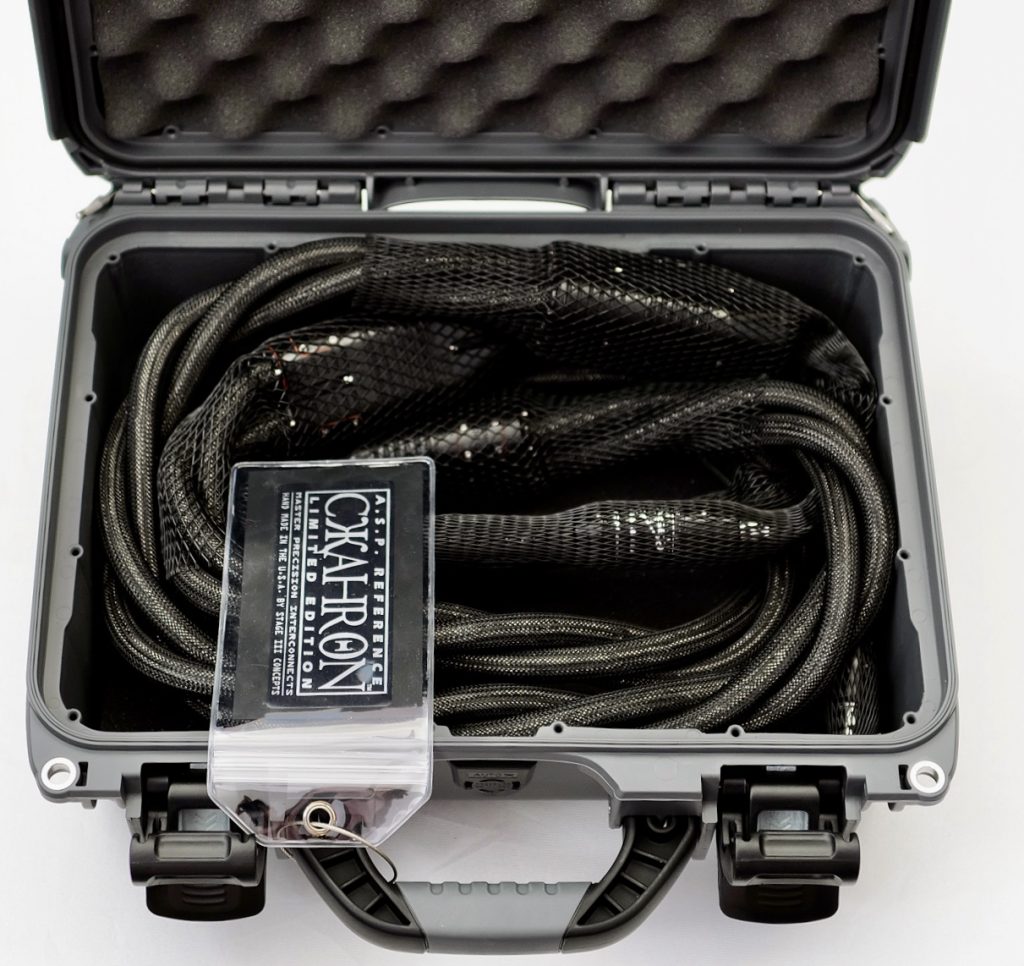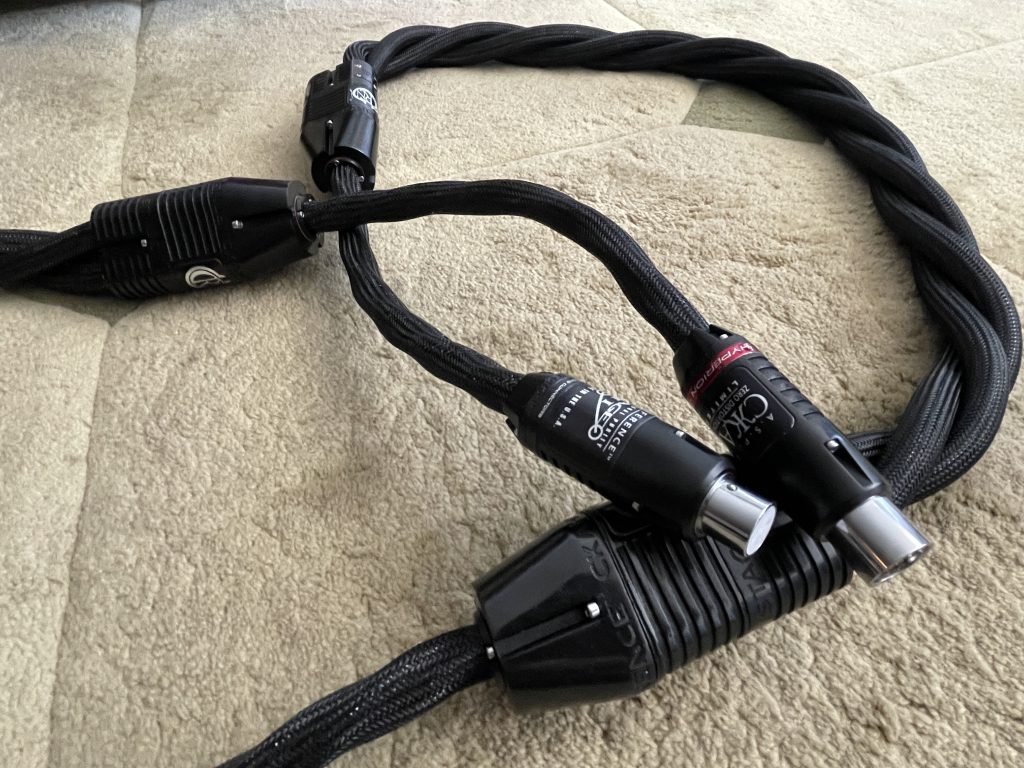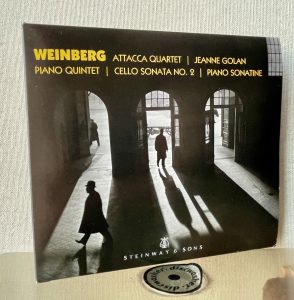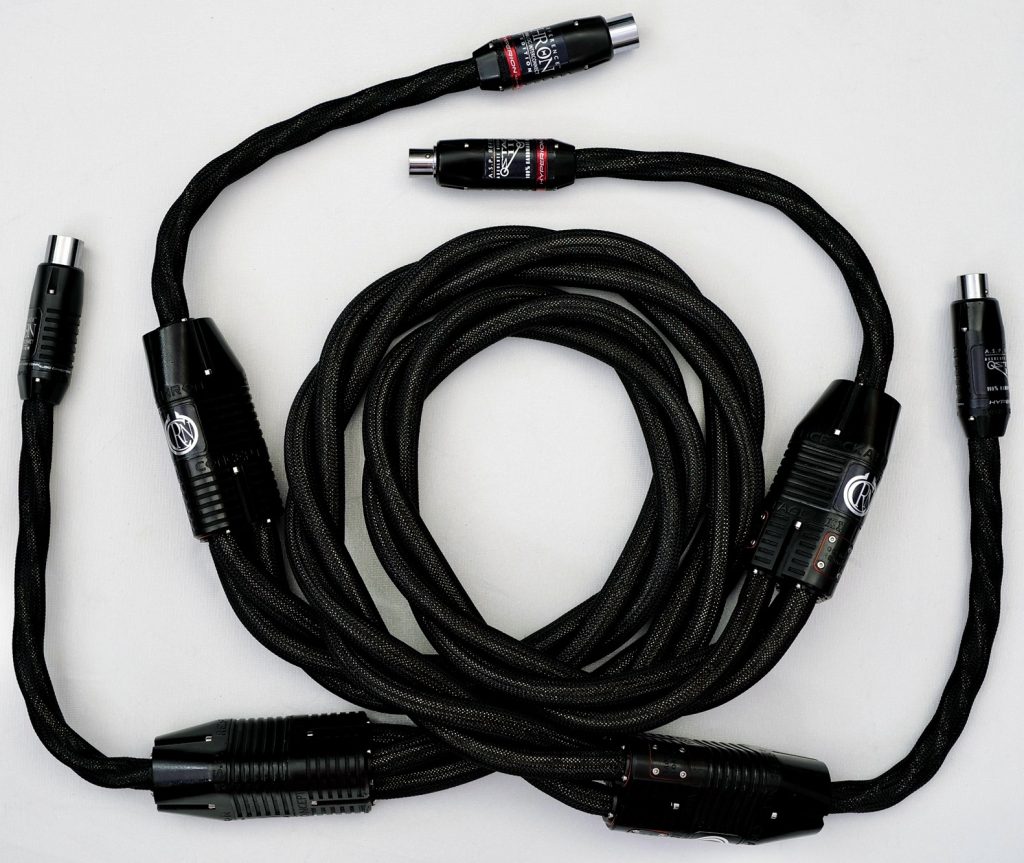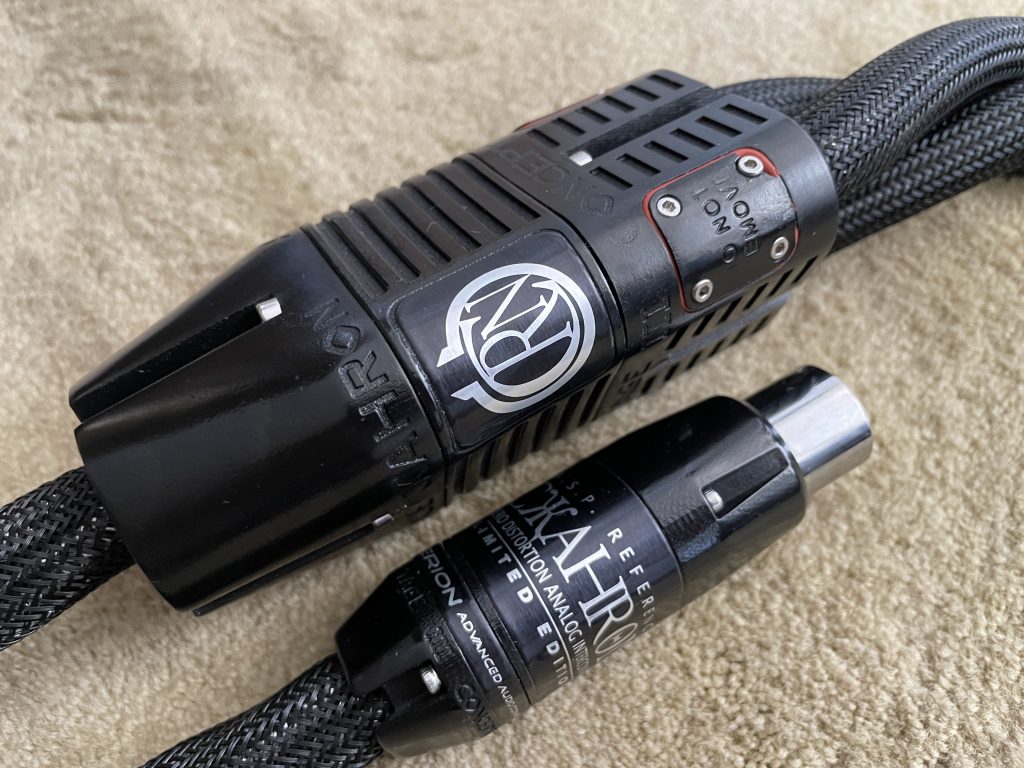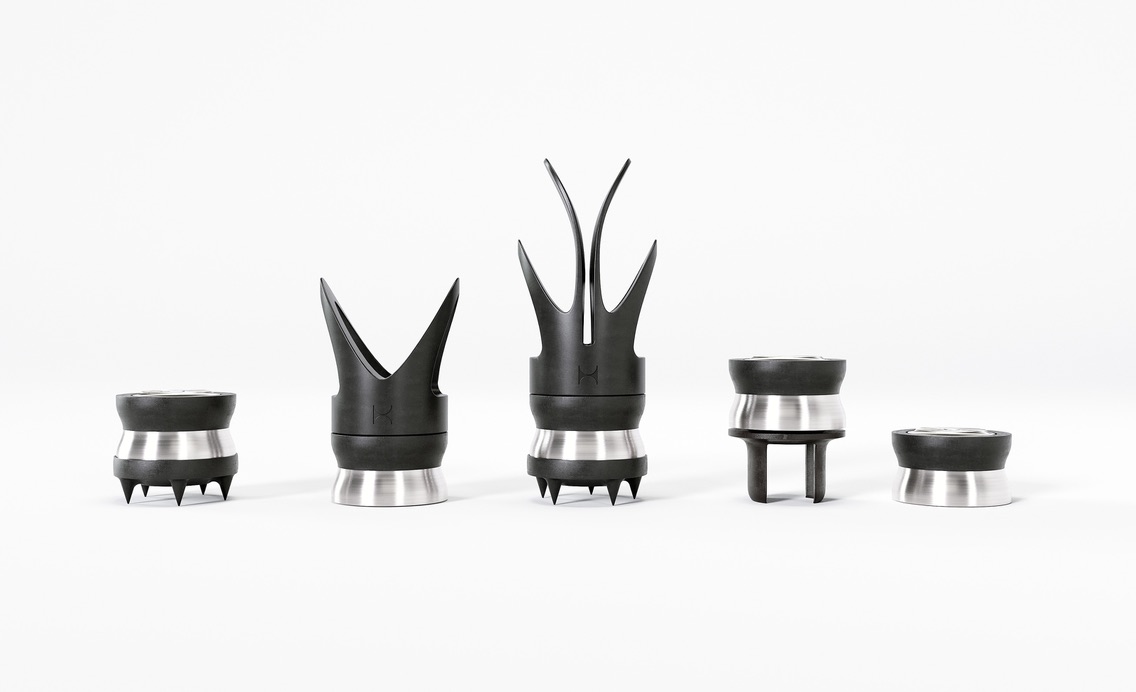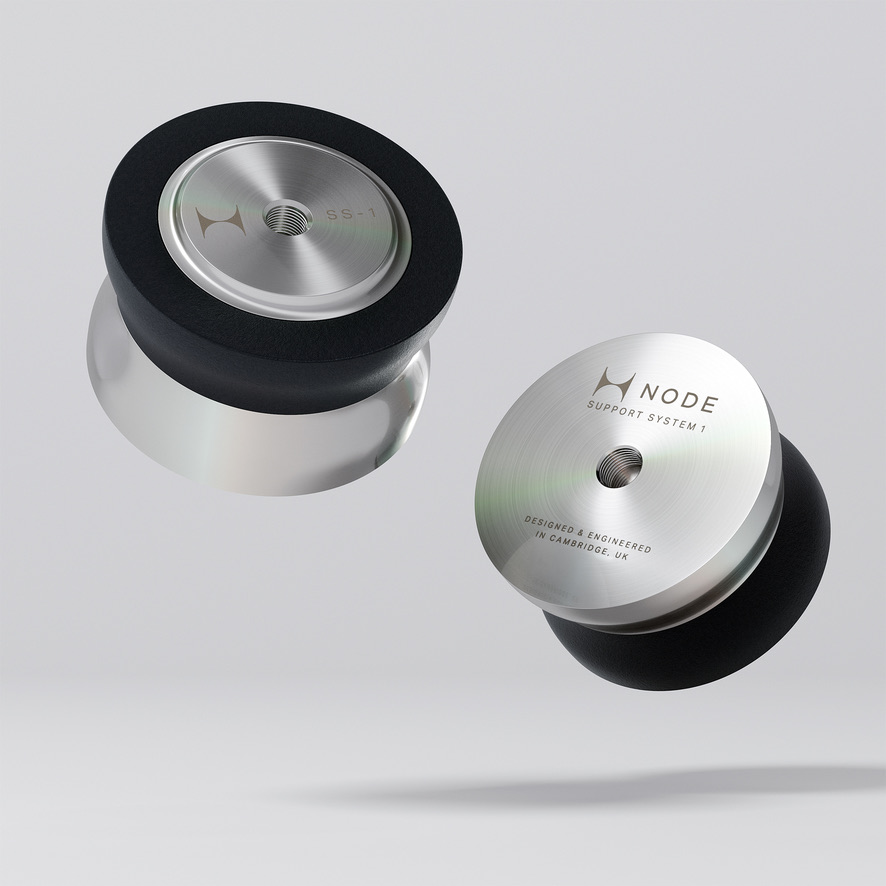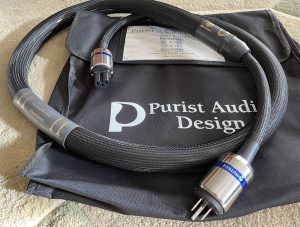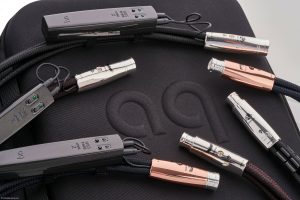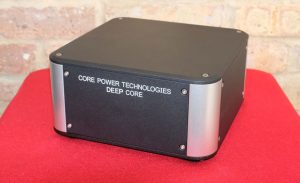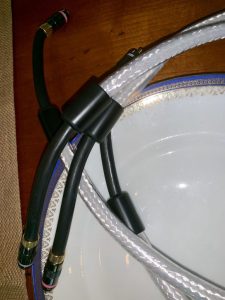Six years have passed since Stage III Concepts introduced their Medusa Speaker Cable, which the brand distributor claimed to be the world's first with a vacuum dielectric. This was no ordinary wire product. I gave it a Writers Choice Award in 2016. The Cerberus Speaker Cable, a new top model in the vacuum line, followed about four years later. Then they redirected their efforts to the power side and came out with the Poseidon PC in the spring of 2021, with the same bold claim of being the world's first. This one garnered a Writers Choice Award in 2021. All of these cables remain in the current lineup. (There is also a vacuum digital and phono cable.) However, they came with two caveats: eye-popping expense and they were of such outlandish girth as to require special care and handling.
Aaudio Desk at the LA Show
In subsequent conversations, Brian Ackerman, the Stage III Concepts global distributor and proprietor of Aaudio Imports, often expressed a wish to complete the Ultimate Statement series of vacuum dielectric cables with an interconnect. Certainly a worthy pursuit, only what about those two caveats? The first—the likely cost to the consumer—could be rationalized by the ambition of the project. The second was tougher. The girth and handling challenges, unacceptable in an interconnect, had to be dealt with in some way.
Months passed, and one day Brian called with news. The youngest member in the Greek mythological pantheon had just descended, the Ckahron interconnect. (The name is an alternate spelling for Charon, the ferryman of the underworld.) There were no claims to being the world's first, since Tara Labs got there when they introduced the Zero IC, back in 2000. I remember reading the glowing review in The Absolute Sound and what a splash the cable made. Tara's design used a single vacuum chamber that held the three conductors. Physically, it was quite lightweight and not difficult in handling, you just had to avoid sharp bends. At the time it was considered super expensive at $12,800/m.
Stage III naturally went about it in their own way (typically choosing the more difficult purist way). Instead of a single vacuum chamber, which is relatively easy, they gave each lead its own chamber, the same as for the Cerberus speaker and Poseidon power cables. There are a total of 6 silver/palladium conductors—two negatives, two positives, and two grounds. Each pair of conductors gets its own heavily damped tube housing. The tube is sealed, then the air is sucked out.
The solution to the girth and handling issues was to use small gauge conductors but more of them, allowing flexibility at the cable ends. Because the body of the wire, where the vacuum is applied, needed larger tubes, it is heavier and less flexible. I made sure to give the body section adequate support by resting it on a component shelf or cable lift.
A Little Music
After we installed a length of the Ckahron interconnect between the DAC and preamp, I played the Mieczyslaw Weinberg Piano Quintet, with the Attacca String Quartet and Jeanne Golan, pianist (Steinway & Sons CD). Right out of the box the Ckahron was alluringly dark, lush, and SET tubey. The woodiness of the string instruments came to the fore, pushing the string component of their sound to secondary. The plentiful woody resonance created an impression of expensive instruments in play.
Rather than use a burn-in device, I was advised to let the cable play music for a couple of hundred hours. Based on my experience with Stage III wires, I knew that meant between 200 to 300 hours. After three days the tubey qualities and the low-end dissipated somewhat, and my ear registered a smooth frequency response, albeit heavy on the bottom, tempered with a good deal of beauty.
Beauty of Sound
What is this beauty of sound? On Soirée – Magdalena Kozena & Friends (Pentatone PTC: 5186671 SACD), it is a mezzo-soprano voice teasing us with a selection of obscure song-stories. Ms. Kozena is a world-class vocalist. Her tessitura (the singer's comfort zone from low to high notes) has always been impressively wide, and so it is here. On a technical level, possibly she was better when she was younger. It doesn't matter. Maturity has more than compensated.
The Ckahron juiced her dynamics, routinely granting her crescendos more force than the chamber music accompaniment. But what excites me is what happens in the energy span between diminuendo and crescendo in terms of the quality of her projection. The cable radically altered my understanding of how she does what she does.
Inside the Crescendo
Some explanation is needed here. I've always considered the gold standard for a crescendo to be when the peaks evidenced the same composure as the moderato passages. That is, it sidestepped glare, breakup, or quality deterioration. The crescendo, a stress point for the system, should not be compromised.
Of course the crescendo needs to be composed, then along comes the Ckahron to show me it's possible to excavate deeper and uncover another level below that. It should sound different. For a singer to crescendo the vocal cords have to push out more air. They must change shape and there is some strain. In Ms. Kozena's case, if the crescendo is on a high note, she consciously shifts from her chest to head voice, while introducing vibrato. In other words, the sound producing mechanism alters which, in turn, alters the vocal quality. With its ability to plumb to previously unexposed levels of detail, the Ckahron presented the evidence and made the case. I heard precisely how her voice changed. And so, my gold standard of composure under stress was superseded.
A Highly Musical Wrapper
And then the Ckahron wraps all this evidence in the most musical envelope. This is a big deal! The rule of thumb is that you get deep acuity or pace-setting bass or the musical envelope. Finding a product that brings them all to the table is rare. But I'm not too surprised, because Stage III pulled this off to a fare-thee-well with the Poseidon PC. From that review:
On the one hand, the Poseidon has got to be the most resolving power cord I've encountered, dredging up previously unheard details and information, with every audible object nailed at precise coordinates, exactly where they're supposed to be. It is the ultimate in specificity.
Yet, as I mentioned, the sound has no constraints, nothing sounds stiff or static and everything flows… The Stage III Poseidon turned out to be a revelation in this regard.
The Frequency Spread
In the real world, the natural dielectric is air. Most audio cable designs try to maximize the amount of air surrounding the conductors. So, what happens when you vacuum it out? In the Stage III Ckahron, it does not become light, untethered, and fleet—quite the opposite. The Ckahron sound is hefty, muscular and very solidly grounded to the earth. Such weighty images are not light on their feet, but neither do they lumber about; they move swiftly enough.
Insertion of a single length of Ckahron interconnect will give you big, room-filling sound. Just looking at it, you know its gonna throw a ton of low-end and that's what rolled out: a big ball of bass frequencies with great tone, body and splendid articulation. It has more low frequency response than any interconnect in my inventory.
But the treble and mid-range are also beautifully rendered, with great body and articulation. Again, looking at the Ckahron, it catches you off-guard to hear gorgeous timbres in such an over-built wire. I pay special attention to this—as does Stage III. Natural timbre is one of the Ckahron's strong suits. Meanwhile, artifacts, including RFI, have disappeared. The super-high purity quotient is the true beneficiary of the vacuum.
A Double Run of C
What can I say after slipping in a second length of the Ckahron to cover the span from DAC to preamp to amps? Already lush and woody, there was even more wood, warmth and density, in addition to dynamics and bass. What incredible grip!
I put on the Schumann Cello Concerto opus 129, with Miklós Perényi, soloist (TACET S 268). TACET likes to advertise that they use an all-tube signal path. This SACD grants my solid-state system something like a SET tube signature, which was both intoxicating and larger than life. I'd have a problem if this were a steady diet. Fortunately, the Ckahron was merely the faithful messenger; as soon as I swapped CDs it switched gears. Save those beautiful sounding TACET discs for when you want to chill out.
More than once, I sat down explicitly intending to critique and came away with nada; I could not find a weakness. Perhaps all this tonal weight and timbral color isn't your cup of tea. You may wonder, "Is it possible to have too much resolution and image separation?" But rather than highlight performance deficiency, these are matters of taste.
Design, Build Quality, and Construction
"Have you ever tried splicing two interconnects together?" Brian relayed how an audiophile broached the idea in a casual conversation years ago. Intrigued, he had some prototypes made. It never panned out, but the idea stuck, and became the genesis for the current Stage III top models featuring multiple conductor tubes. The Ckahron has a little more than two times the number of conductors and the overall gauge of the one-level-down Stage III Gorgon interconnects. The Gorgon is $9,600/1m XLR; the Ckahron is $16,500/1m XLR. You can do similar math for the Poseidon PC (MSRP $25,000/1.5m ) and see how it is a multiple of the lower-model Kraken (roughly two Krakens @ $10,000/1.5m each).
The cosmetic is black on black, the build is over-the-top, and the diameter is massive, adhering to the Stage III style. The Ckahron is designed and fabricated in-house using 100% proprietary elements with no off-the-shelf, mass-produced components, then assembled completely by hand.
Like the other Stage III denizens of the deep, this cable is wider in the middle section and stepped down at the ends. From the XLR connectors, there is a 12" pigtail at each end. Based on the design, the cable's actual length is oversized by about 25%. The pigtail consists of three braided tubes that are already as big as any interconnect I've seen, but no worries, as this part is quite flexible from side to side or up and down. Twisting to align the connector with the mating one on the component offers more resistance. The pigtail terminates in a massive polymer housing, where the three conductor tubes exit separated as larger individual runs and the vacuum is applied. This section of the cable is heavy and stiffer, and looks roughly comparable in girth to an AudioQuest Variable Current Dragon power cord. The XLR connectors are very sturdy and lock securely in place.
Conclusion
By looks alone, it was clear that another edge dweller had landed. The Ckahron Interconnect (an alternate spelling for Charon, the ferryman of the underworld) joins the Cerberus Speaker Cable and Poseidon Power Cord to complete the ambitious vacuum dielectric cable series from Stage III Concepts. I call these products edge dwellers, because they push the boundary of innovation and performance in audio cable design.
The vacuum is considered the perfect dielectric, given our current understanding of materials. Of course, one recalls the Tara Labs Zero from the year 2000. While the Zero is formidable, it doesn't sound anything like the Ckahron. I'm tempted to say no interconnect sounds like the Ckahron, at least the ones I've heard. (Just as the Poseidon power cord has a sound totally its own.)
One should know what they're getting into with the Ckahron. Some wire upgrades leave you overall about where you started and tweak particular areas. Not this guy. The Ckahron Interconnect is transformative with nothing subtle about it. A single length will create the perception of an enlarged, room-filling soundstage. The sound is hefty and athletic. Images have so much body mass and solidity I was left musing, "What incredible grip!" The Ckahron makes other interconnects in my inventory sound weak. You may quibble about all that grip, thinking, "This isn't my cup of tea. I wouldn't do it like that." But now you're in the realm of taste, not performance deficiency.
It's fair to say nothing I heard, no area of performance, is less than world-class. The beastly grip is delivered in a wrapper of lush, saturated tone and variegated timbral colors that satisfies the competing demands of resolution and musicality in spectacular fashion.
The Ckahron Interconnect pulls up right alongside the Poseidon Power Cord. You are not likely to hear a take on sound like this elsewhere. I know I have not—and these wires won't be going back to the distributor. For deep-pocketed audiophiles in pursuit of the loftier altitudes of the Hi-end, audition is a must. The Stage III Statement Cables might be just what you're looking for.
CKAHRON Interconnects
Retail: RCA: $15,000 1.0 meter RCA / Add $3,500 per .5 meter
Retail: XLR: $16,500 1.0 meter XLR / Add $4,000 per .5 meter
Stage III Concepts
Distributor information
Aaudio Imports




